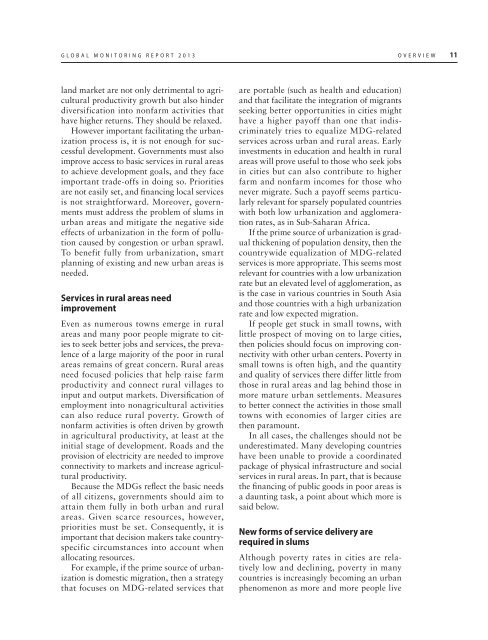rural-urban dynamics_report.pdf - Khazar University
rural-urban dynamics_report.pdf - Khazar University
rural-urban dynamics_report.pdf - Khazar University
You also want an ePaper? Increase the reach of your titles
YUMPU automatically turns print PDFs into web optimized ePapers that Google loves.
GLOBAL MONITORING REPORT 2013 OVERVIEW 11<br />
land market are not only detrimental to agricultural<br />
productivity growth but also hinder<br />
diversification into nonfarm activities that<br />
have higher returns. They should be relaxed.<br />
However important facilitating the <strong>urban</strong>ization<br />
process is, it is not enough for successful<br />
development. Governments must also<br />
improve access to basic services in <strong>rural</strong> areas<br />
to achieve development goals, and they face<br />
important trade-offs in doing so. Priorities<br />
are not easily set, and financing local services<br />
is not straightforward. Moreover, governments<br />
must address the problem of slums in<br />
<strong>urban</strong> areas and mitigate the negative side<br />
effects of <strong>urban</strong>ization in the form of pollution<br />
caused by congestion or <strong>urban</strong> sprawl.<br />
To benefit fully from <strong>urban</strong>ization, smart<br />
planning of existing and new <strong>urban</strong> areas is<br />
needed.<br />
Services in <strong>rural</strong> areas need<br />
improvement<br />
Even as numerous towns emerge in <strong>rural</strong><br />
areas and many poor people migrate to cities<br />
to seek better jobs and services, the prevalence<br />
of a large majority of the poor in <strong>rural</strong><br />
areas remains of great concern. Rural areas<br />
need focused policies that help raise farm<br />
productivity and connect <strong>rural</strong> villages to<br />
input and output markets. Diversification of<br />
employment into nonagricultural activities<br />
can also reduce <strong>rural</strong> poverty. Growth of<br />
nonfarm activities is often driven by growth<br />
in agricultural productivity, at least at the<br />
initial stage of development. Roads and the<br />
provision of electricity are needed to improve<br />
connectivity to markets and increase agricultural<br />
productivity.<br />
Because the MDGs reflect the basic needs<br />
of all citizens, governments should aim to<br />
attain them fully in both <strong>urban</strong> and <strong>rural</strong><br />
areas. Given scarce resources, however,<br />
priorities must be set. Consequently, it is<br />
important that decision makers take countryspecific<br />
circumstances into account when<br />
allocating resources.<br />
For example, if the prime source of <strong>urban</strong>ization<br />
is domestic migration, then a strategy<br />
that focuses on MDG-related services that<br />
are portable (such as health and education)<br />
and that facilitate the integration of migrants<br />
seeking better opportunities in cities might<br />
have a higher payoff than one that indiscriminately<br />
tries to equalize MDG-related<br />
services across <strong>urban</strong> and <strong>rural</strong> areas. Early<br />
investments in education and health in <strong>rural</strong><br />
areas will prove useful to those who seek jobs<br />
in cities but can also contribute to higher<br />
farm and nonfarm incomes for those who<br />
never migrate. Such a payoff seems particularly<br />
relevant for sparsely populated countries<br />
with both low <strong>urban</strong>ization and agglomeration<br />
rates, as in Sub-Saharan Africa.<br />
If the prime source of <strong>urban</strong>ization is gradual<br />
thickening of population density, then the<br />
countrywide equalization of MDG-related<br />
services is more appropriate. This seems most<br />
relevant for countries with a low <strong>urban</strong>ization<br />
rate but an elevated level of agglomeration, as<br />
is the case in various countries in South Asia<br />
and those countries with a high <strong>urban</strong>ization<br />
rate and low expected migration.<br />
If people get stuck in small towns, with<br />
little prospect of moving on to large cities,<br />
then policies should focus on improving connectivity<br />
with other <strong>urban</strong> centers. Poverty in<br />
small towns is often high, and the quantity<br />
and quality of services there differ little from<br />
those in <strong>rural</strong> areas and lag behind those in<br />
more mature <strong>urban</strong> settlements. Measures<br />
to better connect the activities in those small<br />
towns with economies of larger cities are<br />
then paramount.<br />
In all cases, the challenges should not be<br />
underestimated. Many developing countries<br />
have been unable to provide a coordinated<br />
package of physical infrastructure and social<br />
services in <strong>rural</strong> areas. In part, that is because<br />
the financing of public goods in poor areas is<br />
a daunting task, a point about which more is<br />
said below.<br />
New forms of service delivery are<br />
required in slums<br />
Although poverty rates in cities are relatively<br />
low and declining, poverty in many<br />
countries is increasingly becoming an <strong>urban</strong><br />
phenomenon as more and more people live

















